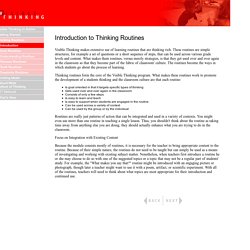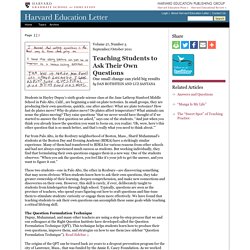

Visible Thinking. Introduction to Thinking Routines Visible Thinking makes extensive use of learning routines that are thinking rich.

These routines are simple structures, for example a set of questions or a short sequence of steps, that can be used across various grade levels and content. What makes them routines, versus merely strategies, is that they get used over and over again in the classroom so that they become part of the fabric of classroom' culture. The routines become the ways in which students go about the process of learning. Thinking routines form the core of the Visible Thinking program. Is goal oriented in that it targets specific types of thinking Gets used over and over again in the classroom Consists of only a few steps Is easy to learn and teach Is easy to support when students are engaged in the routine Can be used across a variety of context Can be used by the group or by the individual.
MakingthinkingvisibleEL.pdf. Education - Right Question Institute. This process explicitly validates all students’ intellectual abilities.– High School History Teacher, New York The reasons behind their questions often bowl me over with their sincerity, the fact that [they] really want to know the answers because it’s important to them, or they feel it would be important for others to know.– 4th Grade Teacher, Chicago The ability to produce questions, improve questions and prioritize questions may be one of the most important—yet too often overlooked—skills that a student can acquire in their formal education.

Strong critical thinking is often grounded in the questions we ask. By deliberately teaching questioning skills, we will be facilitating a process that will help students develop a mental muscle necessary for deeper learning, creativity and innovation, analysis, and problem solving. Join the Movement: Make Question Formulation a part of Every Child’s EducationGet Involved » Are We Asking the Right Questions.
Design Thinking For Students: The Question Formulation Technique. This summer we signed up for a free online module in design thinking.

Organized jointly by Edutopia , IDEO , and Riverdale Country School , the " Design Thinking For Educators " workshop invited participants to model the real process of iterative creation. Design thinking has been gaining traction as a means to foster critical thinking and creativity among learners. Teachers, in fact, can download a toolkit in the methods of design adapted for education. The spring 2012 issue of magazine featured a detailed article about the prospects for design thinking to revolutionize standard classroom practice.
In " An Experience Of "Yes": Independent Schools Begin To Explore and Exploit The Power Of Design Thinking ," Peter Gow describes this mindset as "the posing of a problem, perhaps elegantly framed but more likely ill-structured or open-ended -- and with some constraints. " Design Thinking - Invisible Hearts Project Young Entrepreneurs Step Up Design Is A Method Of Problem Solving. Harvard Education Publishing Group - Home. Students in Hayley Dupuy’s sixth-grade science class at the Jane Lathrop Stanford Middle School in Palo Alto, Calif., are beginning a unit on plate tectonics.

In small groups, they are producing their own questions, quickly, one after another: What are plate tectonics? How fast do plates move? Why do plates move? Do plates affect temperature? What animals can sense the plates moving? Far from Palo Alto, in the Roxbury neighborhood of Boston, Mass., Sharif Muhammad’s students at the Boston Day and Evening Academy (BDEA) have a strikingly similar experience. These two students—one in Palo Alto, the other in Roxbury—are discovering something that may seem obvious: When students know how to ask their own questions, they take greater ownership of their learning, deepen comprehension, and make new connections and discoveries on their own.
The origins of the QFT can be traced back 20 years to a dropout prevention program for the city of Lawrence, Mass., that was funded by the Annie E.